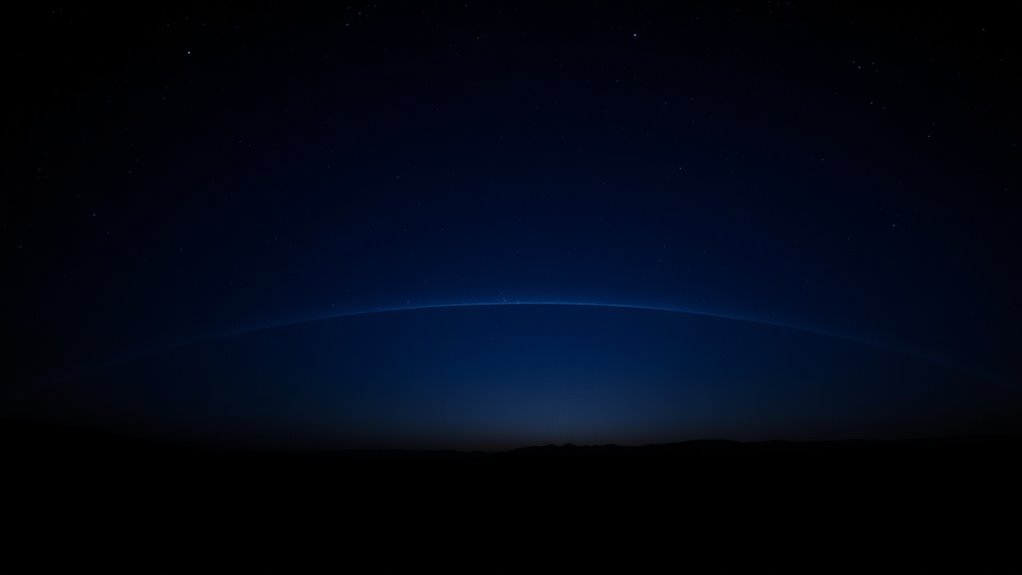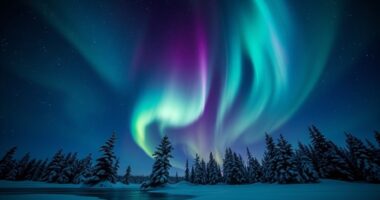Zodiacal light is caused by sunlight reflecting off tiny dust particles in space, mainly from comets and asteroids, spread along the zodiac plane. This faint glow appears as a triangular or pyramid-shaped wedge just after sunset or before sunrise, best seen in dark, clear skies away from city lights. You’ll find it most visible during the equinoxes, especially in rural or high-altitude locations. Curious to discover how to spot it at the right time? Keep exploring.
Key Takeaways
- Zodiacal light is caused by sunlight reflecting off tiny dust particles in the solar system’s zodiacal cloud.
- These dust particles originate mainly from comets and asteroid debris orbiting along the ecliptic plane.
- It appears as a faint, triangular glow along the zodiac, visible just after sunset or before sunrise in dark skies.
- Best viewed in rural, desert, or high-altitude locations during spring and fall, away from light pollution.
- Optimal viewing times are during the hours just before dawn or after sunset when the sky is dark.

Zodiacal light is a faint, triangular glow that appears in the night sky just after sunset or before sunrise, stretching along the path of the zodiac. This celestial phenomenon occurs because of tiny particles spread throughout the solar system, primarily concentrated in the plane of the ecliptic. When sunlight hits these particles—mostly composed of dust from comets and asteroid debris—they reflect enough light to produce this subtle glow. The zodiacal light is best seen in dark, clear skies away from city lights, where the faint illumination isn’t washed out by artificial brightness.
Zodiacal light is a faint, triangular glow seen after sunset or before sunrise along the zodiac path.
The cause of zodiacal light lies in the distribution of dust in our solar system. These microscopic particles orbit the Sun alongside the planets, forming a flattened, disk-shaped zone called the zodiacal cloud. As sunlight travels through space, it encounters this dust, scattering light in all directions. Because the dust is concentrated along the ecliptic plane—the apparent path the Sun takes across the sky—the resulting glow appears as a faint, triangular or pyramid-shaped wedge that extends along this line. This is why zodiacal light appears along the same path as the zodiac constellations.
You might wonder why this phenomenon isn’t visible all the time. The answer is that the brightness of zodiacal light depends on the position of the Sun, Earth, and dust cloud. It’s most visible during the equinoxes, when the ecliptic plane is tilted at an angle that makes the dust’s reflected light more easily observable after sunset or before sunrise. During these times, the dust reflects sunlight back toward you, creating that ethereal glow. The best way to see it is when the sky is dark, and the Sun has just dipped below the horizon or is about to rise. You won’t see zodiacal light during full moon nights because the bright moonlight drowns out the faint glow.
In terms of viewing locations, you’ll have the best luck in areas with minimal light pollution—desert, rural, or high-altitude locations are ideal. The phenomenon is more prominent in the months around spring and fall, especially in the hours just before dawn or after sunset. Since zodiacal light is a direct result of sunlight reflecting off tiny particles in the solar system, it’s a beautiful reminder of the universe’s interconnected celestial phenomena. By understanding its causes, you can better appreciate how our solar system’s dust contributes to this subtle, yet awe-inspiring display in the night sky. Additionally, awareness of the light pollution levels can significantly improve your chances of observing this celestial event.
Frequently Asked Questions
How Does Zodiacal Light Differ From the Milky Way?
Zodiacal light is a faint glow caused by interstellar dust reflecting sunlight, creating a subtle, cone-shaped illumination along the ecliptic. Unlike the Milky Way, which is a dense band of stars and cosmic material across the sky, zodiacal light is a diffuse, smooth glow that appears after sunset or before sunrise. It’s a unique celestial phenomenon that highlights the dust between planets, not the dense star fields of the galaxy.
Can Zodiacal Light Be Seen During a Full Moon?
You probably won’t see zodiacal light during a full moon because its brightness is overwhelmed by the moon’s intense light. The moon phase greatly affects visibility, and a full moon creates significant light pollution, making it harder to observe faint phenomena like zodiacal light. To catch this elusive glow, choose nights with a new moon or minimal moonlight exposure, and head somewhere with dark, clear skies away from city lights.
Is Zodiacal Light Visible From Urban Areas?
Did you know that over 80% of people worldwide live under light-polluted skies? In urban areas, seeing zodiacal light becomes tough because of light pollution effects. Bright city lights wash out faint celestial phenomena, making it nearly impossible to spot zodiacal light without dark skies. If you want to observe it, head to a rural or dark sky site, away from city lights, for the best viewing experience.
How Bright Does the Sky Need to Be to See Zodiacal Light?
To see zodiacal light, your sky needs to be dark enough, meaning low sky brightness. Light pollution from city lights can make it difficult or impossible to spot this phenomenon. Ideally, you should be in a dark rural area away from artificial lights, with minimal sky brightness. Wait for a clear, moonless night, and you’ll have the best chance to observe the faint glow along the ecliptic.
Are There Specific Months Best for Viewing Zodiacal Light?
You’ll find that seasonal visibility greatly influences when you can see zodiacal light. The best times are during spring and fall, when the ecliptic plane angles away from the sun’s glare. For ideal viewing times, go to dark, clear locations just after sunset or before sunrise, ideally between March to May and September to November. Keep an eye on moon phases, as a new moon offers the clearest view.
Conclusion
Next time you gaze up at a dark, clear night, look for the faint glow of zodiacal light stretching along the horizon. Imagine you’re in a remote desert, and the sky is crystal clear. As you observe, you’ll realize this glow is caused by sunlight scattering off tiny dust particles in the solar system’s plane. Just like astronomers studying distant planets, you’re witnessing a beautiful reminder of the cosmic dust that surrounds us all.









